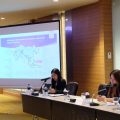India plans joint labour management system with UAE, Bahrain
— April 4, 2008(04-April 2008) NEW DELHI: India may soon become the first country to jointly manage with a migrant destination country the entire cycle of movement of workers from recruitment to return to homeland, which could become a model for a new international framework.
Talks have already been held here in March with United Arab Emirates on a pilot project, the top destination for the majority of Indian emigrants, to discuss the broad outlines.
Bahrain will also be sending a delegation at the end of this month to discuss the scheme. “There will be a common project document that will be replicated in both countries,” said a senior official in the Ministry of Overseas Indian Affairs (MOIA
India’s plans are directly related to discussions at the Abu Dhabi Dialogue held this January between 22 Asian countries of origin and destination of labour. One of the key areas identified for partnership in its declaration document was to develop a “framework for a comprehensive approach to managing the entire cycle of temporary contractual mobility.
Before this, all the stakeholders, the origin and destination countries were only looking at the problem from their perspectives. Nobody was looking at the entire labour mobility cycle,” he said.
India’s representative at the dialogue, Minister for Overseas Indian Affairs Vayalar Ravi, had offered to initiate the plan, and three months later, officials of India and UAE have already drawn up a timeline to discuss, decide and implement the multi-stakeholder project.
“Based on this pilot project, we want to evolve multilateral framework which can be then be adopted by all the 22 countries of origin and destination,” the ministry official, who spoke on condition of anonymity, told IANS.
India and UAE found each other the obvious choice to test the proposed system, with the movement of labour between the two countries listed at number seven on the top ten global migration corridors of the 2008 World Bank Migration and Remittances Fact Book with 2.2 million migrants.
UAE is the number one destination for Indians looking for work abroad, while Indians account for the majority of the foreign worker population in the Gulf nation. The articulated objective of the proposed pilot project is to promote “legal, orderly and managed” mobility, discourage illegal migration, reduce the cost of migration to workers and set up linkages between market demand and supply of skills
A two-member delegation from UAE’s ministry of labour had met MOIA officials and members of civil society groups dealing with migrant worker rights on March 24 to discuss the draft activities drawn up by India. The activities include eleven projects that range from having a set-up to exchange labour market information, to establishing a regulatory mechanism for recruiting agents and drawing up a model contract.
Another interesting idea is to set up a pilot placement module in the three sectors of construction, hospitality and healthcare.
According to MOIA officials, UAE would look into the simplification of the work permit system and entry requirement, along with a detailed re-examination of the sponsorship system.
A proposal that could immensely help overseas workers is for both countries to look at establishing a protocol to allow workers to shift employers after a specific period and search for new opportunities once the contract ends.
At the same time, they would also be considering a provision for workers to return to India after completing their contracts, such as social security measures that could be directly funded by employer and employee.
MOIA officials said they had drawn up an “aggressive” timetable according to which they want to finalise and sign a memorandum of understanding by June, followed by its implementation by early September.
“We want to start writing the draft multilateral framework by September, so that it could be presented for adoption at the meeting of the Global Forum on Migration and Development at Manila in October”, said the senior official.





